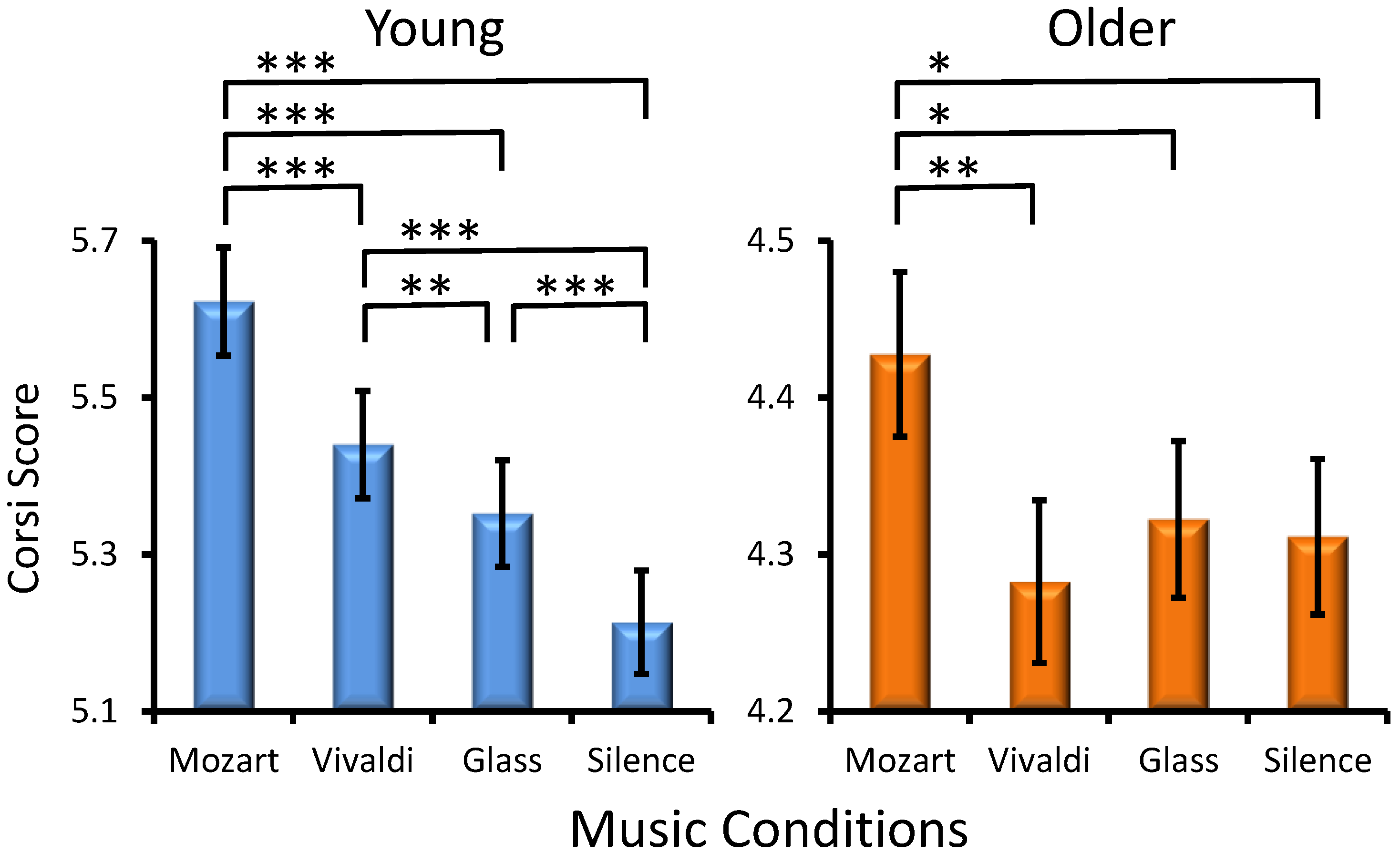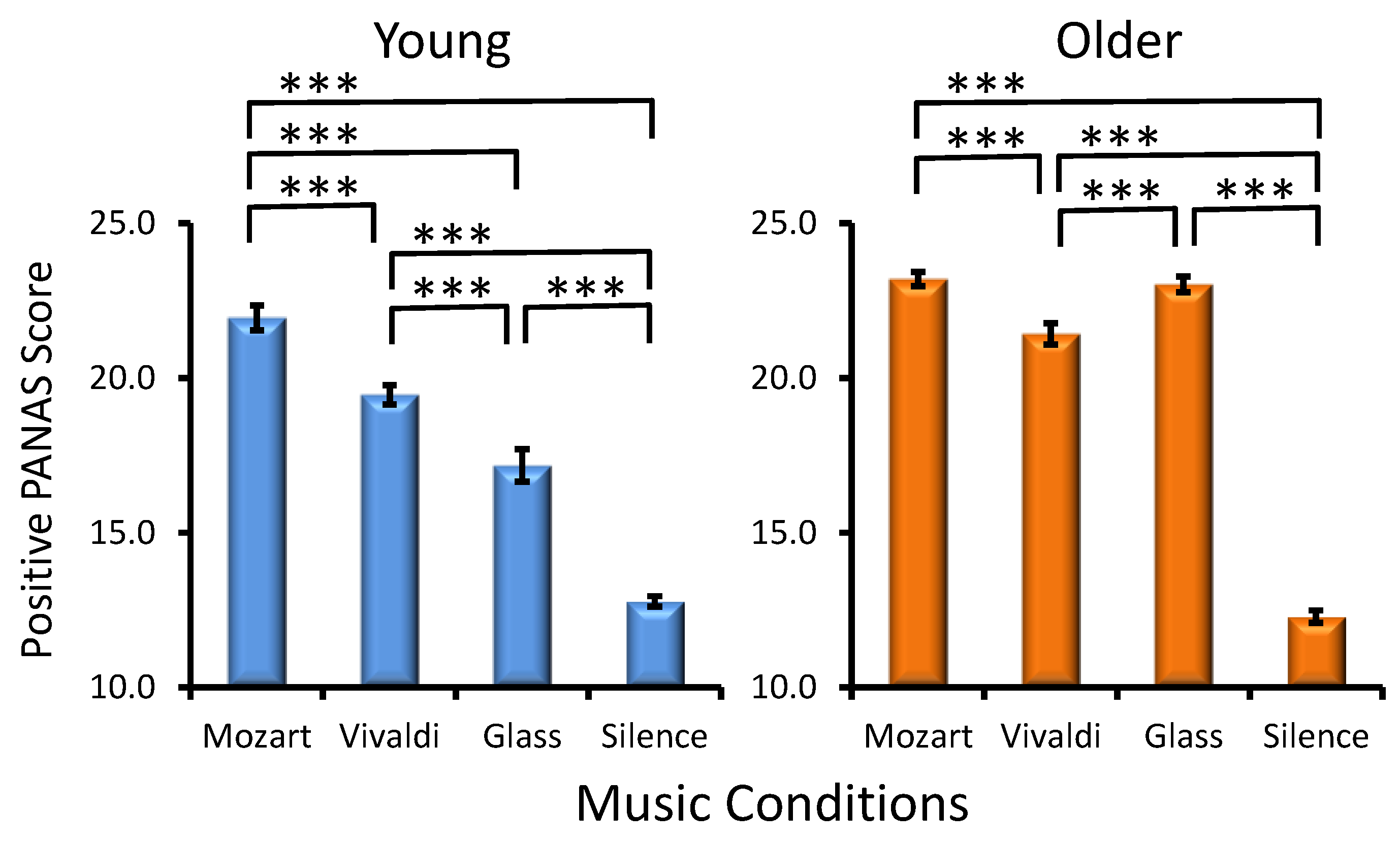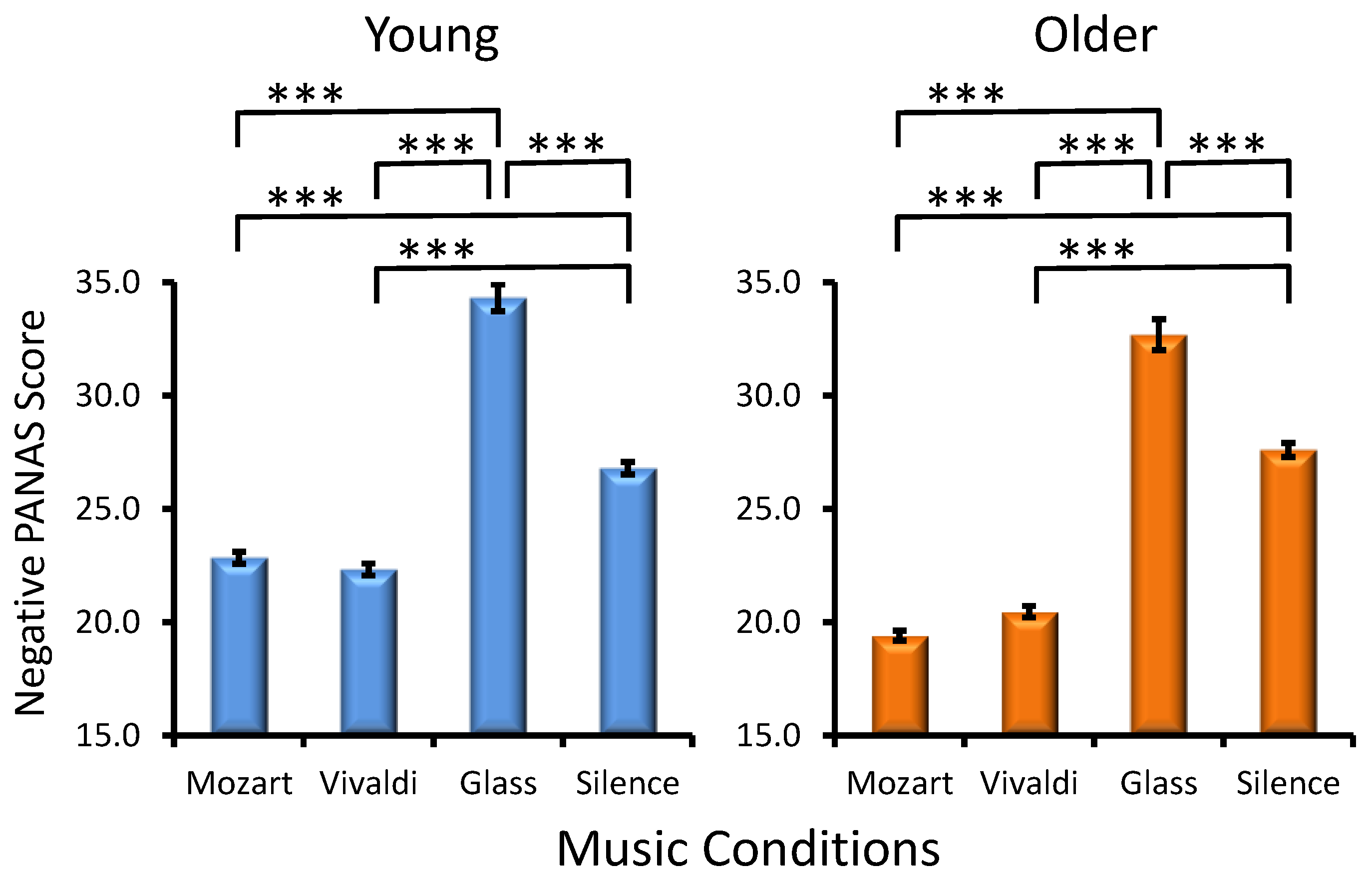Can Brief Listening to Mozart’s Music Improve Visual Working Memory? An Update on the Role of Cognitive and Emotional Factors
Abstract
1. Introduction
2. Method
2.1. Participants
2.2. Musical Stimulation Material
2.3. Visual Storage in Working Memory
2.4. Visual Storage and Processing in Working Memory
2.5. State Affect
2.6. Procedure and Measurable Parameters
2.7. Statistical Analysis
3. Results
3.1. Corsi Blocks Task
3.2. Visual Patterns Test
3.3. PANAS Positive Affect Subscale
3.4. PANAS Negative Affect Subscale
4. Discussion
5. Conclusions
Author Contributions
Funding
Institutional Review Board Statement
Informed Consent Statement
Data Availability Statement
Acknowledgments
Conflicts of Interest
References
- Baddeley, Alan. 2000. The episodic buffer: A new component of working memory. Trends in Cognitive Sciences 4: 417–23. [Google Scholar] [CrossRef]
- Baddeley, Alan, Hazel Emslie, Jonathan Kolodny, and John Duncan. 1998a. Random generation and the executive control of working memory. The Quarterly Journal of Experimental Psychology Section A 51: 819–52. [Google Scholar] [CrossRef] [PubMed]
- Baddeley, Alan, Susan Gathercole, and Constanza Papagno. 1998b. The phonological loop as a language learning device. Psychological Review 105: 158–73. [Google Scholar] [CrossRef] [PubMed]
- Baldi, Elisabetta, and Corrado Bucherelli. 2005. The inverted “u-shaped” dose-effect relationships in learning and memory: Modulation of arousal and consolidation. Nonlinearity in Biology, Toxicology, and Medicine 3: 9–21. [Google Scholar] [CrossRef] [PubMed]
- Berch, Daniel B., Robert Krikorian, and Eileen M. Huha. 1998. The Corsi block-tapping task: Methodological and theoretical considerations. Brain and Cognition 38: 317–38. [Google Scholar] [CrossRef] [PubMed]
- Bidelman, Gavin M., and Claude Alain. 2015. Musical training orchestrates coordinated neuroplasticity in auditory brainstem and cortex to counteract age-related declines in categorical vowel perception. The Journal of Neuroscience 35: 1240–49. [Google Scholar] [CrossRef] [PubMed]
- Bottiroli, Sara, Alessia Rosi, Riccardo Russo, Tomaso Vecchi, and Elena Cavallini. 2014. The cognitive effects of listening to background music on older adults: Processing speed improves with upbeat music, while memory seems to benefit from both upbeat and downbeat music. Frontiers in Aging Neuroscience 6: 284. [Google Scholar] [CrossRef] [PubMed]
- Brown, Louise A. 2016. Spatial-sequential working memory in younger and older adults: Age predicts backward recall performance within both age groups. Frontiers in Psychology 7: 1514. [Google Scholar] [CrossRef]
- Brown, Louise A., Douglas Forbes, and Jean McConnell. 2006. Limiting the use of verbal coding in the Visual Patterns Test. Quarterly Journal of Experimental Psychology 59: 1169–76. [Google Scholar] [CrossRef]
- Brown, Louise A., James R. Brockmole, Alan J. Gow, and Ian J. Deary. 2012. Processing speed and visuospatial executive function predict visual working memory ability in older adults. Experimental Aging Research 38: 1–19. [Google Scholar] [CrossRef]
- Carstens, Christian B., Eugenia Huskins, and Gail W. Hounshell. 1995. Listening to Mozart may not enhance performance on the revised Minnesota Paper Form Board Test. Psychological Reports 77: 111–4. [Google Scholar] [CrossRef] [PubMed]
- Chabris, Christopher F. 1999. Prelude or requiem for the ‘Mozart effect’? Nature 400: 826–27, author reply 827–28. [Google Scholar] [CrossRef] [PubMed]
- Conway, Andrew R.A., Nelson Cowan, Michael F. Bunting, David J. Therriault, and Scott R.B. Minkoff. 2002. A latent variable analysis of working memory capacity, short-term memory capacity, processing speed and general fluid intelligence. Intelligence 30: 163–83. [Google Scholar] [CrossRef]
- Corsi, P. M. 1972. Human Memory and the Medial Temporal Region of the Brain. Unpublished doctoral dissertation, McGill University, Montreal, QC, Canada. [Google Scholar]
- Črnčec, Rudi, Sarah J. Wilson, and Margot Prior. 2006. No evidence for the Mozart effect in children. Music Perception 23: 305–18. [Google Scholar] [CrossRef]
- Daskalou, Vasiliki, and Efthymia Sigkollitou. 2012. Positive and Negative Affect Scale (PANAS). In Psychometric Instruments in Greece. Edited by Anastasios Stalikas, Sofia Triliva and Pagona Roussi. Athens: Pedio. [Google Scholar]
- De Jong, Peter F. 1998. Working memory deficits of reading disable children. Journal of Experimental Child Psychology 70: 75–96. [Google Scholar] [CrossRef] [PubMed]
- Della Salla, Sergio, Alan D. Baddeley, Colin Gray, and Lindsey Wilson. 1997. Visual Patterns Test: VPT. San Diego: Harcourt. [Google Scholar]
- Della Salla, Sergio, Colin Gray, Alan Baddeley, Nadia Allamano, and Lindsey Wilson. 1999. Pattern span: A tool for unwelding visuo-spatial memory. Neuropsychologia 37: 1189–99. [Google Scholar] [CrossRef] [PubMed]
- Derringer, Jaime. 2018. A simple correction for non-independent tests. PsyArXiv. [Google Scholar] [CrossRef]
- Echaide, Claudia, David Del Río, and Javier Pacios. 2019. The differential effect of background music on memory for verbal and visuospatial information. The Journal of General Psychology 146: 443–58. [Google Scholar] [CrossRef] [PubMed]
- Ettlinger, Marc, Elizabeth H. Margulis, and Patrick C. M. Wong. 2011. Implicit memory in music and language. Frontiers in Psychology 2: 211. [Google Scholar] [CrossRef]
- Eysenck, Michael W., Nazanin Derakshan, Rita Santos, and Manuel G. Calvo. 2007. Anxiety and cognitive performance: Attentional control theory. Emotion 7: 336–53. [Google Scholar] [CrossRef]
- Faul, Franz, Edgar Erdfelder, Axel Buchner, and Albert-Georg Lang. 2009. Statistical power analyses using G*Power 3.1: Tests for correlation and regression analyses. Behavior Research Methods 41: 1149–60. [Google Scholar] [CrossRef]
- Fredrickson, Barbara L. 1998. What good are positive emotions? Review of General Psychology 2: 300–19. [Google Scholar] [CrossRef] [PubMed]
- Fredrickson, Barbara L. 2001. The role of positive emotions in positive psychology: The broaden-and-build theory of positive emotions. American Psychologist 56: 218–26. [Google Scholar] [CrossRef] [PubMed]
- Getz, Laura M., Tomas Chamorro-Premuzic, Michael M. Roy, and Karendra Devroop. 2012. The relationship between affect, uses of music, and music preferences in a sample of South African adolescents. Psychology of Music 40: 164–78. [Google Scholar] [CrossRef]
- Giannouli, Vaitsa. 2012. Attention and music. Paper presented at the 12th International Conference on Music Perception and Cognition and the 8th Triennial Conference of the European Society for the Cognitive Sciences of Music, Thessaloniki, Greece, July 23–28; p. 345. [Google Scholar]
- Giannouli, Vaitsa, and Svetlana Popa. 2017. Does listening to Mozart’s music influence visuospatial short-term memory in young adults? European Psychiatry 41: S684. [Google Scholar] [CrossRef]
- Giannouli, Vaitsa, Magda Tsolaki, and Philippos Kargopoulos. 2010. The influence of Mozart’s and Beethoven’s music on reverse mnemonic recall tasks. Psychiatriki 21: 60–67. (In Greek). [Google Scholar] [PubMed]
- Giannouli, Vaitsa, Vasil Kolev, and Juliana Yordanova. 2017. Can Mozart’s music improve spatial-temporal capacity? A theoretical approach. Paper presented at the 5th Congress on Neurobiology, Psychopharmacology & Treatment Guidance, Chalkidiki, Greece, May 25–28; Chalkidiki: International Society of Neurobiology and Psychopharmacology, p. 90. [Google Scholar]
- Giannouli, Vaitsa, Vasil Kolev, and Juliana Yordanova. 2019. Is there a specific Vivaldi effect on verbal memory functions? Evidence from listening to music in young and old adults. Psychology of Music 47: 325–41. [Google Scholar] [CrossRef]
- Gilleta, Karen S., Mirna I. Vrbancic, Lorin J. Elias, and Deborah M. Saucier. 2003. A Mozart effect for women on a mental rotations task. Perceptual and Motor Skills 96: 1086–92. [Google Scholar] [CrossRef]
- Grady, Cheryl L. 1998. Brain imaging and age-related changes in cognition. Experimental Gerontology 33: 661–73. [Google Scholar] [CrossRef]
- Grivol, Marcia A., and Simone R. V. Hage. 2011. Phonological working memory: A comparative study between different age groups. Jornal da Sociedade Brasileira de Fonoaudiologia 23: 245–51. [Google Scholar] [CrossRef]
- Hughes, John R., and John J. Fino. 2000. The Mozart effect: Distinctive aspects of the music—A clue to brain coding? Clinical Electroencephalography 31: 94–103. [Google Scholar] [CrossRef] [PubMed]
- Jaušovec, Norbert, and Katarina Habe. 2005. The influence of Mozart’s sonata K. 448 on brain activity during the performance of spatial rotation and numerical tasks. Brain Topography 17: 207–18. [Google Scholar] [CrossRef] [PubMed]
- Jaušovec, Norbert, Ksenija Jaušovec, and Ivan Gerlic. 2006. The influence of Mozart’s music on brain activity in the process of learning. Clinical Neurophysiology 117: 2703–14. [Google Scholar] [CrossRef]
- Jenkins, John S. 2001. The Mozart effect. Journal of the Royal Society of Medicine 94: 170–72. [Google Scholar] [CrossRef] [PubMed]
- Kessels, Roy P.C., Esther van den Berg, Carla Ruis, and Augustina M.A. Brands. 2008. The backward span of the Corsi Block-Tapping Task and its association with the WAIS-III Digit Span. Assessment 15: 426–34. [Google Scholar] [CrossRef] [PubMed]
- Koelsch, Stefan. 2018. Investigating the neural encoding of emotion with music. Neuron 98: 1075–79. [Google Scholar] [CrossRef] [PubMed]
- Koelsch, Stefan, Martin Rohrmeier, Renzo Torrecuso, and Sebastian Jentschke. 2013. Processing of hierarchical syntactic structure in music. Proceedings of the National Academy of Sciences 110: 15443–48. [Google Scholar] [CrossRef]
- Koelsch, Stefan, Thomas C. Gunter, D. Yves von Cramon, Stefan Zysset, Gabriele Lohmann, and Angela D. Friederici. 2002. Bach speaks: A cortical “language-network” serves the processing of music. NeuroImage 17: 956–66. [Google Scholar] [CrossRef]
- Liégeois-Chauvel, Catherine, Isabelle Peretz, Myriam Babaï, Virginie Laguitton, and Patrick Chauvel. 1998. Contribution of different cortical areas in the temporal lobes to music processing. Brain 121: 1853–67. [Google Scholar] [CrossRef]
- Lin, Hanyu, and Hui Yueh Hsieh. 2011. The effect of music on spatial ability. In International Conference on Internationalization, Design and Global Development. Berlin: Springer, pp. 185–91. [Google Scholar]
- Lints, Amanda, and Shannon Gadbois. 2003. Is listening to Mozart the only way to enhance spatial reasoning? Perceptual and Motor Skills 97: 1163–74. [Google Scholar] [CrossRef]
- Mammarella, Nicola, Beth Fairfield, and Cesare Cornoldi. 2007. Does music enhance cognitive performance in healthy older adults? The Vivaldi effect. Aging Clinical and Experimental Research 19: 394–99. [Google Scholar] [CrossRef] [PubMed]
- McCutcheon, Lynn E. 2000. Another failure to generalize the Mozart effect. Psychological Reports 87: 325–30. [Google Scholar] [CrossRef] [PubMed]
- McKelvie, Pipa, and Jason Low. 2002. Listening to Mozart does not improve children’s spatial ability: Final curtains for the Mozart effect. British Journal of Developmental Psychology 20: 241–58. [Google Scholar] [CrossRef]
- Mellet, Emmanuel, Nathalie Tzourio, Fabrice Crivello, Marc Joliot, Michel Denis, and Bernard Mazoyer. 1996. Functional anatomy of spatial mental imagery generated from verbal instructions. Journal of Neuroscience 16: 6504–12. [Google Scholar] [CrossRef] [PubMed]
- Miyake, Akira, Naomi P. Friedmann, David A. Rettinger, Priti Shah, and Mary Hegarty. 2001. How are visuospatial working memory, executive functioning, and spatial abilities related. A latent-variable analysis. Journal of Experimental Psychology General 130: 621–40. [Google Scholar] [CrossRef] [PubMed]
- Moreno, Sylvian, and Gavin M. Bidelman. 2014. Examining neural plasticity and cognitive benefit through the unique lens of musical training. Hearing Research 308: 84–97. [Google Scholar] [CrossRef] [PubMed]
- Moussard, Aline, Patrick Bermudez, Claude Alain, William Tays, and Sylvian Moreno. 2016. Life-long music practice and executive control in older adults: An event-related potential study. BrainResearch 1642: 146–53. [Google Scholar] [CrossRef]
- Nantais, Kristin M., and E. Glenn Schellenberg. 1999. The Mozart effect: An artifact of preference. Psychological Science 10: 370–73. [Google Scholar] [CrossRef]
- Newman, Joan, John H. Rosenbach, Kathryn L. Burns, Brian C. Latimer, Helen R. Matocha, and Elaine Rosenthal Vogt. 1995. An experimental test of “The Mozart Effect”: Does listening to his music improve spatial ability? Perceptual and Motor Skills 81: 1379–87. [Google Scholar] [CrossRef]
- Nicholls, Louise A. Brown, and Brad English. 2020. Multimodal coding and strategic approach in young and older adults’ visual working memory performance. Neuropsychology, Development, and Cognition. Section B, Aging, Neuropsychology, and Cognition 27: 83–113. [Google Scholar] [CrossRef]
- Nyholt, Dale R. 2004. A simple correction for multiple testing for single-nucleotide polymorphisms in linkage disequilibrium with each other. American Journal of Human Genetics 74: 765–69. [Google Scholar] [CrossRef] [PubMed]
- Palmiero, Massimiliano, Raffaella Nori, Carmelo Rogolino, Simonetta D’Amico, and Laura Piccardi. 2016. Situated navigational working memory: The role of positive mood. Cognitive Processing 16: 327–30. [Google Scholar] [CrossRef] [PubMed]
- Panksepp, Jaak, and Günther Bernatzky. 2002. Emotional sounds and the brain: The neuro-affective foundations of musical appreciation. Behavioural Processes 60: 133–55. [Google Scholar] [CrossRef] [PubMed]
- Papagno, Costanza, Tim Valentine, and Alan Baddeley. 1991. Phonological short-term memory and foreign-language vocabulary learning. Journal of Memory and Language 30: 331–47. [Google Scholar] [CrossRef]
- Patel, Aniruddh D. 2003. Language, music, syntax and the brain. Nature Neuroscience 6: 674–81. [Google Scholar] [CrossRef] [PubMed]
- Pauwels, Ernest K.J., Duccio Volterrani, Giuliano Mariani, and Magdalena Kostkiewics. 2014. Mozart, music and medicine. Medical Principles and Practice 23: 403–12. [Google Scholar] [CrossRef] [PubMed]
- Pryse-Phillips, William. 2003. Companion to Clinical Neurology, 2nd ed. Oxford: Oxford University Press. [Google Scholar]
- Rauscher, Frances H., and Gordon L. Shaw. 1998. Key components of the Mozart effect. Perceptual and Motor Skills 86: 835–41. [Google Scholar] [CrossRef] [PubMed]
- Rauscher, Frances H., Gordon L. Shaw, and Catherine N. Ky. 1993. Music and spatial task performance. Nature 365: 611. [Google Scholar] [CrossRef] [PubMed]
- Reuter-Lorenz, Patricia A. 2002. New visions of the aging mind and brain. Trends in Cognitive Sciences 6: 394–400. [Google Scholar] [CrossRef]
- Ribeiro, Fabiana Silva, Flávia H. Santos, and Pedro B. Albuquerque. 2023. Do emotions evoked by music modulate visuospatial working memory capacity? A physiological study. Psychology of Music 51: 1192–208. [Google Scholar] [CrossRef]
- Rideout, Bruce E., and Catherine M. Laubach. 1996. EEG correlates of enhanced spatial performance following exposure to music. Perceptual and Motor Skills 82: 427–32. [Google Scholar] [CrossRef] [PubMed]
- Rideout, Bruce E., Shannon Dougherty, and Lisa Wernert. 1998. Effect of music on spatial performance: A test of generality. Perceptual and Motor Skills 86: 512–14. [Google Scholar] [CrossRef]
- Roth, Edward A., and Kenneth H. Smith. 2008. The Mozart effect: Evidence for the arousal hypothesis. Perceptual and Motor Skills 107: 396–402. [Google Scholar] [CrossRef] [PubMed]
- Rowe, Gillian, Lynn Hasher, and Josée Turcotte. 2008. Age differences in visuospatial working memory. Psychology and Aging 23: 79–84. [Google Scholar] [CrossRef]
- Smith, Andrew, Beth Waters, and Hywel Jones. 2010. Effects of prior exposure to office noise and music on aspects of working memory. Noise and Health 12: 235–43. [Google Scholar] [CrossRef] [PubMed]
- Steele, Kenneth M., Joshua D. Brown, and Jaimily A. Stoecker. 1999. Failure to confirm the Rauscher and Shaw description of recovery of the Mozart effect. Perceptual and Motor Skills 88: 843–88. [Google Scholar] [CrossRef] [PubMed]
- Stough, Con, Bridget Kerkin, Tim Bates, and Gordon Mangan. 1994. Music and spatial IQ. Journal of Personality and Individual Differences 17: 695. [Google Scholar] [CrossRef]
- Strait, Dana L., Jane Hornickel, and Nina Kraus. 2011. Subcortical processing of speech regularities underlies reading and music aptitude in children. Behavioral and Brain Functions 7: 44. [Google Scholar] [CrossRef]
- Thompson, William F., E. Glenn Schellenberg, and Gabriela Husain. 2001. Arousal, mood, and the Mozart effect. Psychological Science 12: 248–51. [Google Scholar] [CrossRef]
- Ullman, Michael T. 2001. A neurocognitive perspective on language: The declarative/procedural model. Nature Reviews Neuroscience 2: 717–26. [Google Scholar] [CrossRef]
- Warren, Jason D. 1999. Variations on the musical brain. Journal of the Royal Society of Medicine 92: 571–75. [Google Scholar] [CrossRef] [PubMed]
- Watson, David, and Lee Anna Clark. 1999. The PANAS-X: Manual for the Positive and Negative Affect Schedule-Expanded Form. Iowa City: The University of Iowa. [Google Scholar]
- Wilson, Thomas L., and Tina L. Brown. 1997. Re-examination of the effect of Mozart’s music on spatial-task performance. Journal of Psychology 131: 365–70. [Google Scholar] [CrossRef]
- Zajonc, Robert B. 1980. Feelings and thinking: Preferences need no inferences. American Psychologist 35: 151–75. [Google Scholar] [CrossRef]




| Mozart | Vivaldi | Glass | Silence | Total | |
|---|---|---|---|---|---|
| Young | 32 (20.5%) | 63 (39.9%) | 38 (24.1%) | 25 (15.8%) | 158 |
| Older | 27 (17.7%) | 53 (34.9%) | 48 (31.2%) | 24 (15.8%) | 152 |
| All participants | 59 (19.0%) | 116 (37.4%) | 86 (27.7%) | 49 (15.8%) | 310 |
Disclaimer/Publisher’s Note: The statements, opinions and data contained in all publications are solely those of the individual author(s) and contributor(s) and not of MDPI and/or the editor(s). MDPI and/or the editor(s) disclaim responsibility for any injury to people or property resulting from any ideas, methods, instructions or products referred to in the content. |
© 2024 by the authors. Licensee MDPI, Basel, Switzerland. This article is an open access article distributed under the terms and conditions of the Creative Commons Attribution (CC BY) license (https://creativecommons.org/licenses/by/4.0/).
Share and Cite
Giannouli, V.; Yordanova, J.; Kolev, V. Can Brief Listening to Mozart’s Music Improve Visual Working Memory? An Update on the Role of Cognitive and Emotional Factors. J. Intell. 2024, 12, 54. https://doi.org/10.3390/jintelligence12060054
Giannouli V, Yordanova J, Kolev V. Can Brief Listening to Mozart’s Music Improve Visual Working Memory? An Update on the Role of Cognitive and Emotional Factors. Journal of Intelligence. 2024; 12(6):54. https://doi.org/10.3390/jintelligence12060054
Chicago/Turabian StyleGiannouli, Vaitsa, Juliana Yordanova, and Vasil Kolev. 2024. "Can Brief Listening to Mozart’s Music Improve Visual Working Memory? An Update on the Role of Cognitive and Emotional Factors" Journal of Intelligence 12, no. 6: 54. https://doi.org/10.3390/jintelligence12060054
APA StyleGiannouli, V., Yordanova, J., & Kolev, V. (2024). Can Brief Listening to Mozart’s Music Improve Visual Working Memory? An Update on the Role of Cognitive and Emotional Factors. Journal of Intelligence, 12(6), 54. https://doi.org/10.3390/jintelligence12060054






